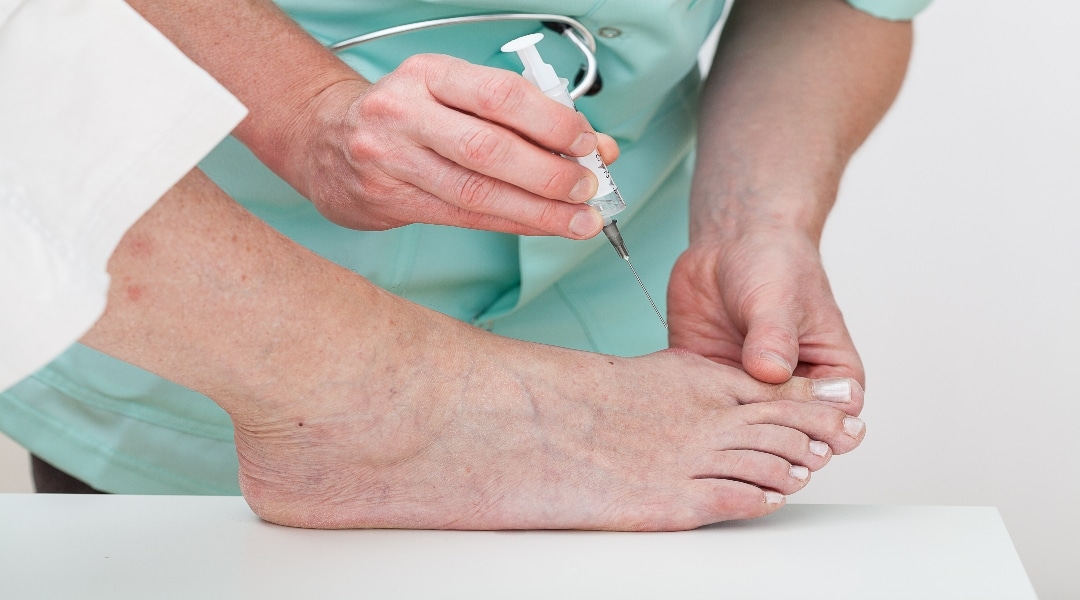Non-Surgical Bunion Treatment Options
Despite what you may have heard, the road of bunion treatment does not always lead to surgery.
While it is true that bunion surgery is the only real option for eliminating the bunion itself, there are many conservative bunion treatment options that can effectively relieve the symptoms of a bunion enough to live a much more comfortable life.
It is these options we will be focusing on here.
Why Not Always Go Straight to Bunion Surgery?
There will be cases when a bunion is so severe or unique that conservative treatments will not provide the results you need. This is when surgical options are typically considered.
Otherwise, alternatives to surgery are well worth considering for a few reasons.
First, the primary goals of bunion treatment are to:
- relieve problematic symptoms
- maintain mobility and range of motion
- slow or stop the progression of the deformity
A bunion does not always have to be corrected to achieve these goals, and very rarely (if ever) should bunion surgery be conducted purely for cosmetic reasons.
Second, bunion surgery is a complex procedure. Like many similar types of surgery, it leaves a lasting impact on the body and takes an extended amount of time to recover from. Not everyone is best prepared or able to undergo a bunion procedure, based on their health and other circumstances.
Third, even when bunion surgery is performed, it is not always a 100 percent guarantee that the condition has been eliminated. Instability in the joint may still exist, and there may be a small chance that a bunion can begin developing once again. If you are younger, this might be a reason to not consider bunion surgery at this time.
What Are Conservative Options for Bunion Treatment?
At Advanced Foot & Ankle Centers of Illinois, we take the time to comprehensively examine the condition of your bunion and the factors surrounding it, and then make care recommendations based on what should have the best results for your individual needs. No two cases are ever quite the same, and certainly shouldn’t be treated that way.
If you have a bunion in very early stages and causing minimal trouble, we may recommend certain at-home forms of treatment, such as moleskin pads and foot soaks. The items for these forms of treatment are readily attainable over-the-counter.
If home remedies are not enough, we have additional forms of conservative bunion treatment options we can prescribe, demonstrate, or administer within our office. These options include:
Custom Orthotics and Shoes
In many cases, an irregularity in foot structure can lead to excess pressure being placed on the unstable bunion joint as you stand and move. The role of custom orthotics and specialized shoes is to redistribute that pressure away from the joint and provide additional forms of cushioning and comfort.
Specialized shoes are more accommodating to a bunion than most standard shoes on the market, and often more accommodating of custom orthotics as well. There are less severe cases, however, in which standard shoes with wide and open toe boxes can be suitable.
Corn and Callus Removal
The shifting of the big toe and the prominent bump of the bunion can cause plenty of friction, either between the shoe and a toe or between the toes themselves. This can result in the formation of uncomfortable and painful corns and calluses.
We can safely remove these toughened areas (please never try to do so yourself if you have poor circulation or diabetes) and help keep them from returning by addressing the areas of friction.
Night Splints
A night splint for a bunion is a device typically worn overnight, while you sleep. It helps hold the toe in a more natural alignment, which is often helpful in increasing comfort and slowing or stopping the bunion’s progression.
The use of a night splint is a long-term strategy, and it should be noted that it will not force the bunion to be corrected – only assist in keeping it from becoming worse. Even so, using them regularly can significantly reduce painful symptoms, making them a very worthy consideration.
Physical Therapy Stretches and Exercises
The better you can condition the muscles, tendons, ligaments, and other soft tissues that surround the unstable joint, the better you can guard against excess forces and further drifting.
We can recommend a series of stretches and exercises that you can perform as part of a routine to build strength and conditioning in your feet. We can set these up in a way that you can accomplish without much challenge, as consistency is key.
And if you are currently active in sports and exercise, we can also recommend ways to keep your level of movement without worrying so much about it affecting your bunion – or your bunion affecting your movement.
Cortisone Injections
During a time when a bunion is especially painful, we may consider injections of cortisone to provide relief. These considerations are made on a case-by-case basis, and are not used as a consistent, long-term plan.
Don’t Delay in Addressing Your Bunion
When you begin treatment for a bunion can have a big influence on whether you may require surgery in the future. The earlier, the better!
If you are not certain whether you currently have a bunion or not, it is still worth seeing us. Just don’t wait until things become bad to start seeking help.
Contact any of our area offices to schedule an appointment. We also provide telemedicine appointments if you would prefer to have an initial consultation from the comfort of your own home.

